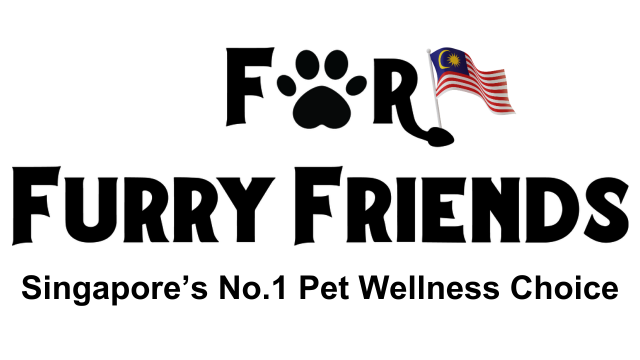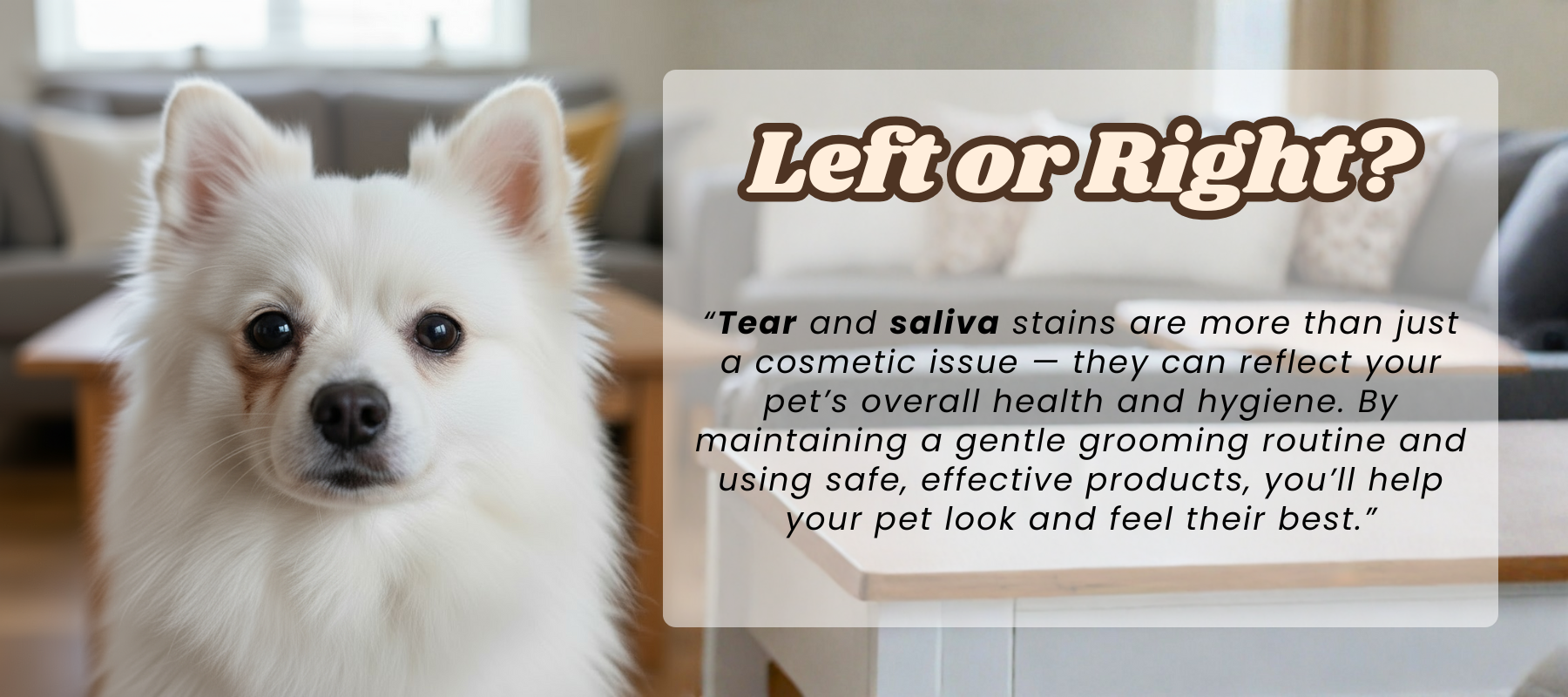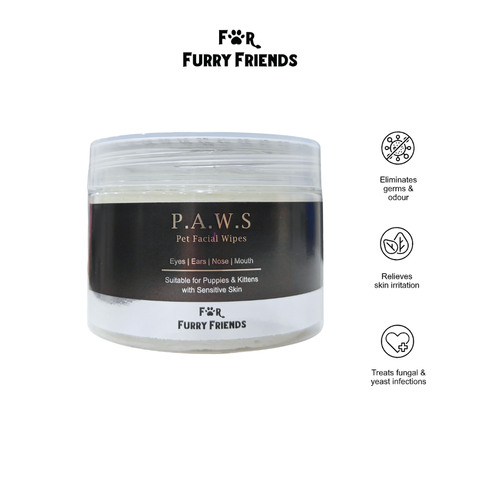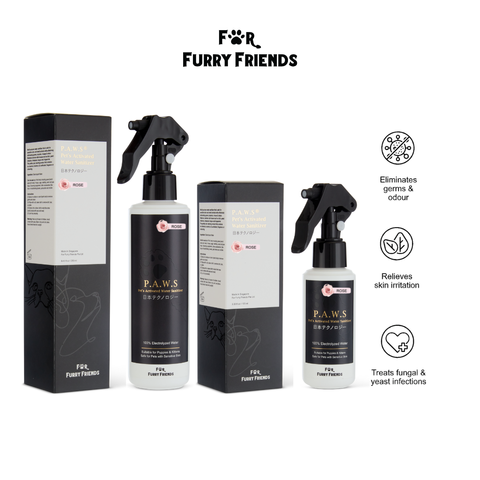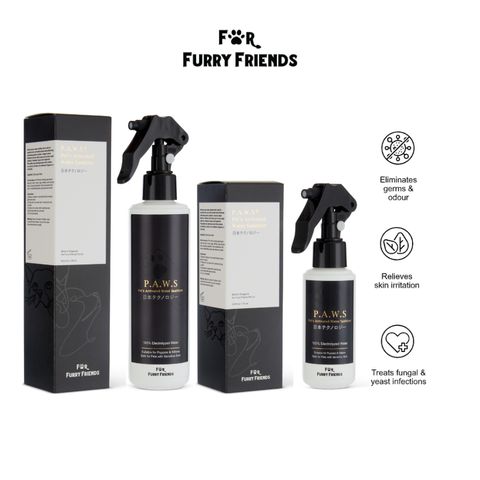Under the eyes (tear stains)
Around the mouth or chin (saliva stains)
On the paws (from licking)
Blocked tear ducts (epiphora): Tears overflow instead of draining properly.
Allergies: Dust, food, or pollen can trigger watery eyes or irritation.
Diet or water quality: Tap water with minerals or additives can worsen staining.
Facial structure: Flat-faced breeds like Shih Tzus, Maltese, Persians, and Bulldogs are more prone.
Bacteria or yeast buildup: Moist fur creates the perfect environment for microbes that darken stains.
Moisten a soft cotton pad with the cleanser.
Gently wipe the stained area once or for best results, twice daily.
For excessive staining, do not let the tear or saliva stays on the fur more than 12 hours consecutively.
Limited-ingredient or grain-free diets
Natural proteins like chicken, salmon, or lamb
Foods rich in omega-3 and omega-6 fatty acids for healthy skin and coat
Using human wipes, baby wipes, or alcohol-based products
Applying hydrogen peroxide or bleach
Using unapproved antibiotics
Choosing products with parabens, fragrances, or alcohol
Wipe your pet’s face at least twice daily.
Keep the fur around the eyes and mouth short and clean.
Choose high-quality pet food with limited fillers and artificial colors.
Use filtered water.
Schedule regular vet visits to check tear duct and skin health.
P.A.W.S Pet Facial Wipes – gentle, safe, and effective for daily use.
P.A.W.S Spray – antibacterial, soothing, and more cost effective.
👀 What Are Tear Stains and Saliva Stains in Pets?
If you’ve ever noticed reddish-brown streaks under your dog’s eyes or discoloration around your cat’s mouth or paws, you’re not alone. These are tear stains and saliva stains, and they’re common — especially in white or light-colored pets.
These stains form when porphyrins, natural compounds that contain iron found in tears and saliva, oxidize after contact with air, leaving that stubborn rusty tint on your pet’s fur.
Common affected areas:
Top keywords: tear stains on dogs, remove tear stains naturally, cat tear stain remover, dog saliva stains, pet grooming tips
🧬 Why Do Tear Stains and Saliva Stains Happen?
Before treating them, it helps to understand why they occur. Here are some of the most common reasons:
👉 Tip: If your pet’s stains suddenly worsen, chat with us to find out what you have done differently.
🧼 How to Safely Remove Tear and Saliva Stains
Here’s how to remove stains effectively and safely — no harsh chemicals required.
1. Clean Daily with products that effectively remove the main cause: Porphyrins
Use a pet-safe facial cleaner formulated with soothing natural ingredients like chamomile or P.A.WS.
2. Feed High Quality Food
Choosing a Low-quality kibble filled with artificial colors, additives, and fillers can irritate your pet’s system and trigger excessive tearing.
3. Trim Fur Around the Eyes and Mouth
Keeping hair short helps prevent tears or saliva from soaking into the fur.
4. Offer Filtered or Distilled Water
Reduce mineral intake by switching to filtered water. This small change can make a big difference!
5. Wipe After Meals or Playtime
If your pet drools or eats wet food, gently wipe around their mouth after every meal to prevent saliva stains. Do rememeber to use Pet Wipes that can remove porphyrins.
🥗 Diet & Nutrition Tips to Prevent Tear and Saliva Stains
What your pet eats — and drinks — plays a big role in keeping their face clean and stain-free.
1. Avoid Mineral-Heavy Water
Tap water often contains high levels of iron, copper, and magnesium, which can darken tear & saliva stains. Use filtered or distilled water to minimize mineral buildup and staining.
2. Choose High-Quality, Natural Food
Low-quality kibble filled with artificial colors, additives, and fillers can irritate your pet’s system and trigger excessive tearing.
Look for:
3. Watch Iron Intake — But Don’t Eliminate It
Iron contributes to the color of tear stains because it’s part of the porphyrin compound. However, completely avoiding iron is not recommended, as it’s essential for your pet’s blood health. The key is balance, not elimination.
4. Address Food Allergies
Allergies to ingredients like beef, dairy, or wheat can cause watery eyes and saliva staining. If you suspect an allergy, try a hypoallergenic or novel protein diet (like duck or venison).
5. Support Digestive Health
Adding probiotics or digestive enzymes (after consulting your vet) can improve nutrient absorption and reduce inflammation, leading to fewer stains over time.
💡 For Furry Friends Tip:
Pair a clean, nutritious diet with daily facial cleaning using For Furry Friends Pet Facial Wipes for the best results inside and out.
🚫 What to Avoid When Treating Tear Stains
Some popular “hacks” online can do more harm than good. Steer clear of:
Your pet’s skin is delicate — always use pet-formulated natural grooming products.
💡 Prevention: The Key to a Stain-Free Face
Prevention is easier than cure! Follow these simple, consistent habits:
Consistency keeps stains away — and your furkids looking fresh!
❤️ Final Thoughts: A Clean Face Is a Happy Face
Tear and saliva stains are more than just a cosmetic issue — they can reflect your pet’s overall health and hygiene. By maintaining a gentle grooming routine and using safe, effective products, you’ll help your pet look and feel their best.
✨ For Furry Friends Tip: Turn your daily cleaning into bonding time! A few minutes of care keeps their coat bright, soft, and healthy — and strengthens your connection too.
🛍️ Shop the For Furry Friends Stain-Free Care Range
Keep your pet fresh and stain-free with For Furry Friends’ natural grooming essentials:
